Michael Swanwick's Blog, page 15
October 5, 2024
Gaaays in Spaaace in Roxborough
.
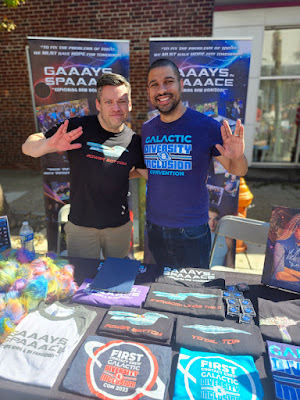
I had a brief encounter with these two young men at the street fair a block from my house, here in Roxborough. It would have been longer, but I was carrying an abundance of street food for lunch and wanted to get it home while it was still hot. I did chat long enough, however, to learn that the non-profit organization they were representing was Gaaays in Spaaace (they emphasized the triplet-As in each word) and that it existed to encourage diversity and inclusion in both science fiction and actual space travel.
(You can learn more at their rather lavish website. Their mission statement and history can be found at https://www.gaaaysinspaaace.org/about.)
Thinking about them, I was reminded of a conversation I had with Alex Shvartsman at Capclave recently. I said something about how admirable the Chinese science fiction community was--positive, hard-working, anxious to make the world a better place--and he said, "But that's the science fiction community anywhere in the world. We're all like that." Then, a little wryly, "We're certainly not in it for the money."
So, yes, Alex was right. These guys are working on the media side of the street whereas I and so many of my friends are working the literary side. But we're all working for the common good.
This has been my moment of positivism for the week. I'll be my usual grumpy self again by this time tomorrow.
*
All Souls Night (Part 5 of 31)
.






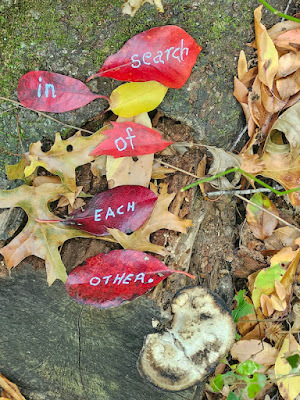
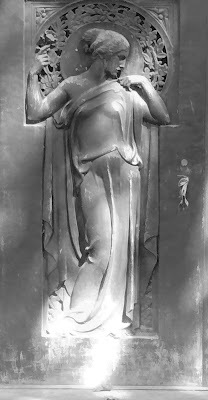
CONTINUED TOMORROW.
Above: Every Autumn, I write a Halloween story, write it out on leaves (one word per leaf), photograph the leaves, and then leave them where.I found them. The story is then serialized, starting on October 1 and concluding on the 31st--All Souls Day.
*
October 4, 2024
All Souls Night (Part 4 of 31)
.
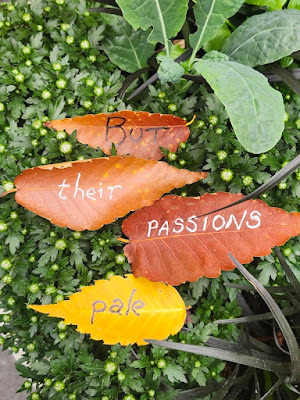



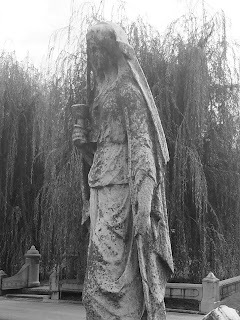
CONTINUED TOMORROW.
Above: Every Autumn, I write a Halloween story, write it out on leaves (one word per leaf), photograph the leaves, and then leave them where.I found them. The story is then serialized, starting on October 1 and concluding on the 31st--All Souls Day.
*
October 3, 2024
All Souls Night (Part 3 of 31)
.
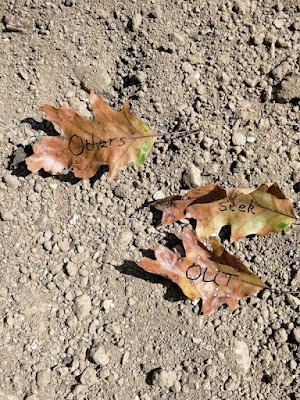
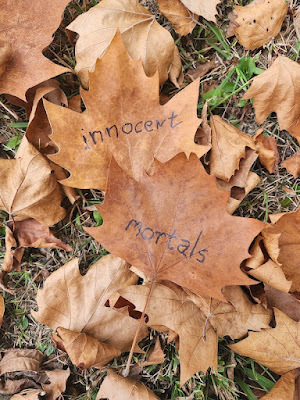


CONTINUED TOMORROW.
Above: Every Autumn, I write a Halloween story, write it out on leaves (one word per leaf), photograph the leaves, and then leave them where.I found them. The story is then serialized, starting on October 1 and concluding on the 31st--All Souls Day.
*
October 2, 2024
All Souls Night (Part 2 of 31)
.

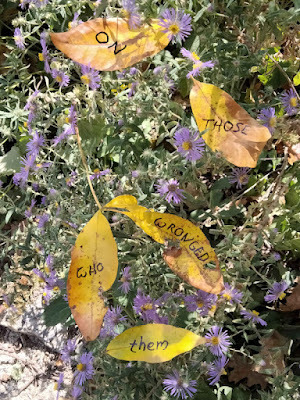

CONTINUED TOMORROW.
Above: Every Autumn, I write a Halloween story, write it out on leaves (one word per leaf), photograph the leaves, and then leave them where.I found them. The story is then serialized, starting on October 1 and concluding on the 31st--All Souls Day.
*
October 1, 2024
ALL SOULS NIGHT (Part 1 of 31)
.

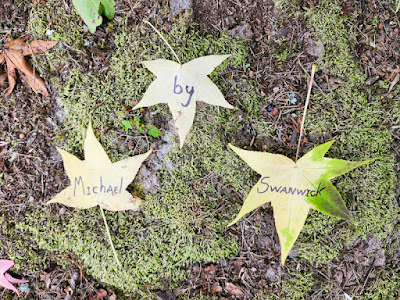
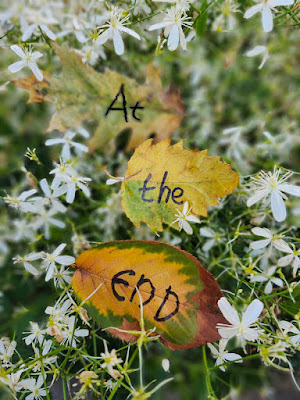







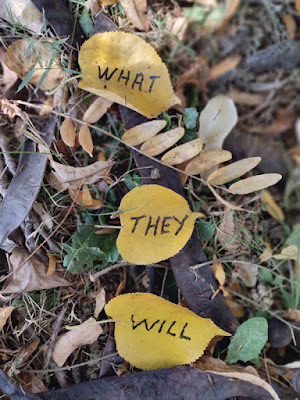

CONTINUED TOMORROW.
Above: Every Autumn, I write a Halloween story, write it out on leaves (one word per leaf), photograph the leaves, and then leave them where.I found them. The story is then serialized, starting on October 1 and concluding on the 31st--All Souls Day.
*
A Goat for Azazel - On Sale This Saturday!
.
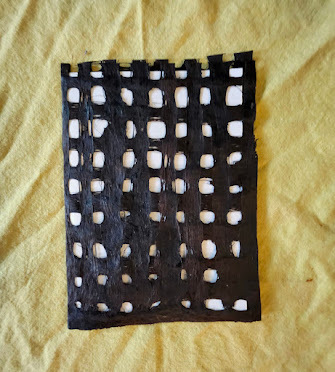
Dragonstairs Press has a new chapbook coming out this weekend--and it's a beaut! The proposal, written by Grania Davis based on notes by Avram Davidson, synopsizes the plot of an unwritten Dr. Esterhazy novel--a "ghost novel," as it were. I devoutly wish it existed in full but, in that absence, reading about what might have been was a pleasure.
Did you know that the good doctor had a wife?
Here's what Marianne wrote in her announcement:
Recently, Grania's son, Seth Davis, shared the proposal with people he thought would find it interesting. Dragonstairs Press pounced.
The Avram Davidson estate has kindly allowed the one time use of this material.
A Goat for Azazel is essentially a reproduction of the novel proposal, formatting and idiosyncratic spellings preserved, and is offered as a tribute to Avram Davidson, one of the foremost short fiction writers of the 20th century, and to Grania Davis, his collaborator and passionate supporter. Michael Swanwick, a huge fan and appreciator of Avram, has added a brief, signed afterword to the work. It is produced in an edition of 80, roughly 6” x 7”, numbered and hand-stitched, with wrappers made of Mexican amate bark paper, chosen to commemorate Avram's and Grania's years in Mexico.
It will be offered for sale on Saturday, October 5, 2024, at noon, Philadelphia time (Eastern Daylight Savings) at www.dragonstairs.com. $15 domestic, $18 international.
--
Marianne Porter (she/her)
editor, publisherDragonstairs Press
And, since you wondered . . .
Avram lied to me! We were in correspondence for a time and in one of his letters he agreed with my speculation that, Dr. Esterhazy being an ultra-rationalist--he could not be brought into then-present times by spiritual or even scientific means. And all the while, he had notes specifying that exact same thing!
A writer telling untruths. I can feel the foundations of reality shiver.
Above: Looks nice, dunnit? Periodically, I have to remind people that Dragonstairs is not my nanopress. It's wholly owned and operated by Marianne. I'm just the resident content provider--and for this chapbook, not even that.*
September 26, 2024
The Delany Test
.

In one of his essays, Samuel R. Delany observed that if the number of women in a room passes a certain threshold (I think it was forty percent, but it may have been thirty or even less), men will think that they are a majority presence. It's something I've thought about, off and on, ever since reading it.
The other day, I finished watching KAOS on Netflix, an eight-part series in which the modern world is ruled by the ancient Greek gods. It's trash, but entertaining trash with some terrific performances, particularly that of Jeff Goldblum as Zeus. The ending was a little weak, but otherwise it was lots of fun.
And it seemed to have a lot of women's roles in it, an impression bolstered by female multiples--three Furies, three Fates (but I gather they're nonbinary/genderfluid), and the Tacitas Hera surrounded herself with. I speculated that somebody had made a commitment to gender parity.
So Marianne went to the Internet Movie Data Base and counted the cast members: a total of 85, of whom 38 were women. Doing the math, it came out to... 42%. Close enough.
Once again, the Delany Test proved to be solid. It made me wonder how overwhelmingly male-dominated the television I usually watch is.
*
September 13, 2024
from my Commonplace Book . . .
.
A word of explanation: A commonplace book is a collection of excerpts and quotations that strike whoever keeps the book as worth saving. It's like a diary that contains not one word of one's own. Today's entry is notable chiefly for the date when it was written.
Irving, Emerson, Thoreau, Hawthorne, Lowell, Holmes--certainly our fathers were not afraid of essays. Nevertheless, somewhere about the opening of our own day, an iron-bound tradition became erected in the publishing business, at least in the United States, that books of essays would not sell; could not be made to sell even sufficiently to avoid a considerable loss on the investment of manufacture; in fact, were quite impossible as a publishing venture.
-- Robert Cortes Holliday, 1923
*
August 27, 2024
CHAINS OF THE SEA: The Movie
.

Strange and delightful news!
My late friend Gardner Dozois' novella, "Chains of the Sea," has been optioned for a movie. I know that there were nibbles on various works when he was alive, but I believe this is the first story to get this far in the process.
The back-story of how the novella came to the attention of the filmmakers after being discovered by the UFO Disclosure community would certainly have made Gardner laugh. You can read all about it here.
Gardner's story is delicate, haunting, and beautifully written. And it has aliens. You can find it in any of his short fiction collections.
And for those who are interested in literary footnotes . . .
The title for my novel, Stations of the Tide, did not come easily. It had the unfortunate working title of Sea-Change, and I and everyone I knew put a lot of work into coming up with possible alternatives--dozens and maybe even hundreds of them--before coming up with one that made me happy. (All the seasoned writers reading this are right now nodding their heads in wry sympathy.) At one point, while I was writing it, I told Gardner that Chains of the Sea would be the perfect title if it wasn't already his.
"Go ahead, use it!" he said. "It's not doing me any good."
I didn't, of course. But that was so typically Gardner. However, in my novel, in the background of the main plot, there are snatches of a telenovela that everyone is watching while they wait for the sea to swallow up the Tidewater. I never gave the name of the show, but in my mind and in my notes as well, it was called Chains of the Sea.
I told Gardner that but, of course, he wasn't impressed.
Above: I swiped this picture of Gardner from Wikipedia. I forget who originally took it--somebody at Locus Magazine, I think. But I believe it's best photo of the man ever taken.
*
Michael Swanwick's Blog
- Michael Swanwick's profile
- 552 followers



